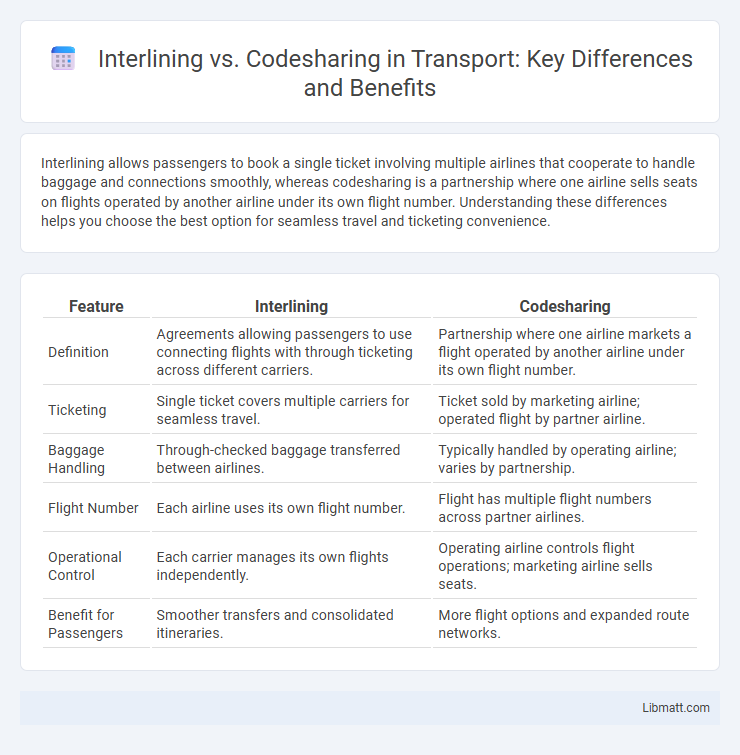Interlining allows passengers to book a single ticket involving multiple airlines that cooperate to handle baggage and connections smoothly, whereas codesharing is a partnership where one airline sells seats on flights operated by another airline under its own flight number. Understanding these differences helps you choose the best option for seamless travel and ticketing convenience.
Table of Comparison
| Feature | Interlining | Codesharing |
|---|---|---|
| Definition | Agreements allowing passengers to use connecting flights with through ticketing across different carriers. | Partnership where one airline markets a flight operated by another airline under its own flight number. |
| Ticketing | Single ticket covers multiple carriers for seamless travel. | Ticket sold by marketing airline; operated flight by partner airline. |
| Baggage Handling | Through-checked baggage transferred between airlines. | Typically handled by operating airline; varies by partnership. |
| Flight Number | Each airline uses its own flight number. | Flight has multiple flight numbers across partner airlines. |
| Operational Control | Each carrier manages its own flights independently. | Operating airline controls flight operations; marketing airline sells seats. |
| Benefit for Passengers | Smoother transfers and consolidated itineraries. | More flight options and expanded route networks. |
Introduction to Interlining and Codesharing
Interlining and codesharing are essential concepts in the airline industry that facilitate seamless travel and expanded route options. Interlining allows passengers to book multiple flights on different carriers using a single ticket, simplifying connections and baggage transfers. Codesharing enables airlines to market and sell seats on partner flights under their own flight numbers, enhancing Your booking flexibility and access to a wider network.
Defining Interlining: What Does It Mean?
Interlining refers to an agreement between airlines that allows passengers to book a single itinerary involving multiple carriers, seamlessly transferring their checked baggage and boarding passes across flights. This practice enhances travel convenience by coordinating schedules and services between partner airlines, ensuring smoother connections. Understanding interlining helps you navigate complex routes and optimize your travel experience with multi-airline journeys.
Understanding Codesharing Agreements
Codesharing agreements allow airlines to share flight numbers and coordinate schedules, giving passengers access to a wider network without booking multiple tickets. Unlike interlining, which involves separate tickets and luggage transfers, codesharing offers seamless travel experiences under a single reservation. Understanding these agreements helps you make informed decisions about connecting flights and airline partnerships.
Key Differences Between Interlining and Codesharing
Interlining involves airlines coordinating to issue a single ticket for passengers traveling on multiple carriers, simplifying baggage transfers and check-ins across different airlines. Codesharing allows one airline to market and sell seats on a flight operated by another carrier, expanding network reach without operational integration. While interlining streamlines travel logistics, codesharing enhances marketing and sales collaboration between airlines.
Benefits of Interlining for Passengers
Interlining offers passengers seamless travel by allowing the transfer of checked baggage between multiple airlines without the need for re-checking, reducing stress and saving time during layovers. It simplifies ticketing and itinerary management by enabling a single booking across partner airlines, enhancing convenience and reliability. Your journey becomes smoother with coordinated flight schedules and improved connection options, ensuring a more efficient travel experience compared to codesharing.
Advantages of Codesharing for Airlines and Travelers
Codesharing enables airlines to expand their route networks without additional aircraft or crew, optimizing fleet utilization and reducing operational costs. Travelers benefit from increased flight options, seamless connections, and through-ticketing, which simplifies booking and baggage handling. This collaboration enhances airline revenue streams while offering passengers greater convenience and access to a broader range of destinations.
Ticketing and Baggage Policies: Interlining vs Codesharing
Interlining allows You to book a single ticket covering multiple airlines, simplifying ticketing and ensuring through-checking of baggage to your final destination. Codesharing often requires separate baggage handling policies by each carrier, which might mean collecting and rechecking luggage during layovers. Understanding these differences helps manage Your travel experience seamlessly and avoid unexpected baggage fees or transfer issues.
Airline Partnerships: How Interlining and Codesharing Work Together
Interlining and codesharing enhance airline partnerships by enabling seamless travel across multiple carriers through coordinated ticketing and scheduling. Interlining allows passengers to book a single itinerary with through-checked baggage across different airlines, while codesharing extends market reach by marketing another airline's flights under one carrier's code. Together, these systems streamline connectivity, increase route options, and improve operational efficiency within global airline alliances.
Choosing the Best Option for Your Travel Needs
Interlining enables seamless transfers and baggage handling between airlines under a single ticket, ideal for complex itineraries and minimizing travel disruptions. Codesharing enhances flight options and schedule flexibility by allowing multiple airlines to market the same flight, often resulting in improved route availability and loyalty program benefits. Selecting the best option depends on prioritizing convenience with interlining or expanded choices via codesharing to align with your specific travel itinerary and preferences.
Future Trends in Airline Collaboration
Future trends in airline collaboration emphasize increased integration between interlining and codesharing to streamline passenger experiences and operational efficiency. Advanced digital platforms and blockchain technology enable seamless data exchange for interlining, while codesharing expands network reach through strategic alliances like oneworld, Star Alliance, and SkyTeam. Enhanced collaboration fosters personalized travel, dynamic pricing, and greater route optimization driven by AI and machine learning innovations.
interlining vs codesharing Infographic

 libmatt.com
libmatt.com